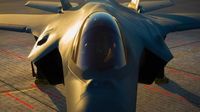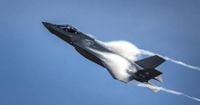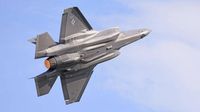Britain is on the verge of a major shift in its nuclear defence strategy, exploring the reintroduction of air-launched nuclear weapons for the first time since the Cold War. This move, driven by rising tensions with Russia and evolving global threats, could see British fighter jets armed with tactical nuclear bombs, establishing a second pillar alongside the existing submarine-based Trident system.
According to reports from The Sunday Times and various news outlets, the UK government is engaged in sensitive discussions with the United States about acquiring F-35A Lightning II stealth fighter jets. These aircraft would be capable of carrying the B61 gravity bomb, a low-yield nuclear weapon already deployed by the US and some NATO allies. Defence Secretary John Healey and Chief of the Defence Staff Admiral Sir Tony Radakin are leading these talks, with Prime Minister Keir Starmer also understood to support the initiative.
This potential development marks the most significant change in Britain's nuclear posture since the Cold War ended. Currently, the UK's nuclear deterrent relies solely on the Vanguard-class submarines armed with Trident missiles. Introducing air-launched nuclear capabilities would diversify Britain's nuclear delivery options, aligning it more closely with NATO partners like the US, which maintain a triad of land, sea, and air-based nuclear forces.
Healey has been candid about the changing security landscape, warning that "the world is definitely becoming more dangerous," with nuclear risks on the rise. Speaking to The Sunday Times, he said, "For the first time since the end of the Cold War, we face seriously increasing risks of state-on-state conflict." This assessment underscores the government's rationale for expanding nuclear deterrence in response to Russia's increasingly aggressive posture.
The strategic defence review, set to be unveiled on Monday, June 2, 2025, will outline these considerations but is not expected to explicitly commit to the purchase of air-launched nuclear weapons. Instead, it will recommend enhancing the UK's contribution to NATO's shared nuclear deterrent and maintaining industrial readiness for rapid rearmament if required.
The F-35A jets under consideration have a range of approximately 14,000 kilometers (around 8,700 miles) and are capable of carrying the B61 bomb, which has a variable yield between 0.3 and 0.4 kilotons. To put this into perspective, the bomb dropped on Hiroshima in 1945 had an estimated yield of 15 kilotons, making the B61 a much lower-yield weapon designed for tactical use rather than strategic city-destroying strikes.
Possession of such tactical nuclear weapons would provide NATO and the UK with a flexible deterrent option, allowing for a calibrated response to limited nuclear aggression without immediately escalating to full-scale nuclear war. This is particularly relevant given concerns about Russia's nuclear threats and the possibility of limited nuclear strikes in the ongoing conflict in Ukraine or against NATO's eastern flank.
Admiral Sir Tony Radakin has reportedly viewed the expansion of the nuclear deterrent as the UK's highest defence priority, emphasizing the need to diversify nuclear delivery systems. Britain currently stands alone among major nuclear powers in relying on a single platform — submarines — to launch its nuclear arsenal. In contrast, the United States maintains a nuclear triad, launching from land-based missiles, submarines, and aircraft.
Alongside the nuclear expansion, the strategic defence review will propose a significant boost in conventional military capabilities. The government plans to invest £6 billion in replenishing munitions stockpiles, developing new ballistic missile defence systems, and re-establishing a civilian home guard. There will also be a resurgence in naval shipbuilding, a new underwater surveillance programme to protect critical infrastructure like internet cables and energy pipelines, and a long-term target to increase the size of the British Army.
Prime Minister Keir Starmer, writing in The Sun on Sunday, emphasized the urgency of these measures, stating, "We will meet this moment head on — by mounting the kind of response not seen before in most of our lifetimes." He added, "We will restore Britain’s war-fighting readiness as the central purpose of our Armed Forces," highlighting the direct threat posed by states with advanced military forces, namely Russia.
The government is also committed to increasing defence spending, aiming to reach 3% of GDP by 2034, up from the current target of 2.5%. This increase is seen as essential to fund both nuclear and conventional force enhancements.
However, the proposed nuclear expansion has drawn criticism, particularly from Scottish politicians and anti-nuclear campaigners. David Kelly of the Scottish Campaign for Nuclear Disarmament expressed shock at the plans, criticizing the reliance on American technology and the potential for "kill switches" on weapons controlled by the US. SNP MSP Bill Kidd and Alba party leader Kenny MacAskill voiced concerns about the financial cost during a time of economic hardship and the risks posed by nuclear weapons stationed in or near Scotland.
MacAskill warned that "Labour are lurching towards war," arguing that the UK is already an "onshore aircraft carrier for the United States" and that introducing American nuclear weapons on British jets would further endanger Scotland. Scottish Greens co-leader Patrick Harvie highlighted safety concerns, referencing past leaks of radioactive material at Faslane, home to the UK's nuclear submarines, and called for an end to nuclear weapons, noting that over 70 nations have signed the Treaty on the Prohibition of Nuclear Weapons.
The backdrop to these discussions includes recent reports of a secret Russian "hit list" targeting UK towns and military sites, including the Royal Navy's nuclear submarine shipyard at Barrow-in-Furness and locations such as Cumbria, Hull, Edinburgh, Aldershot, and Portsmouth. Russian President Vladimir Putin's repeated nuclear threats have intensified fears of escalation, making the UK's efforts to bolster its deterrent all the more pressing.
Former cabinet secretary Simon Case, an expert on nuclear deterrence, has urged the government to develop a second method of nuclear delivery, emphasizing that deterrence requires adversaries to be certain of a credible and diverse threat. He remarked, "As I look out on my children’s lives, the next ten and probably 20 years is going to be dominated by this inter-state conflict. It feels to me that we across the western alliance need to get our skates on and be ready."
While the strategic defence review stops short of committing to immediate purchases of nuclear-capable jets, the groundwork is being laid for a robust expansion of Britain's nuclear and conventional military capabilities. The government’s £1.5 billion investment in six new munitions factories aims to place the UK on a wartime footing, ensuring rapid production and replenishment of arms if conflict with Russia escalates.
This comprehensive approach to national security reflects a recognition that the post-Cold War era of relative peace has given way to a more volatile and dangerous world. Britain’s move to diversify its nuclear deterrent, invest in advanced military technology, and strengthen its armed forces signals a determined effort to prepare for the challenges ahead.



